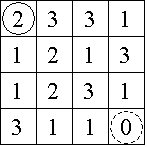Pascal's Travels
Time Limit: 2000/1000 MS (Java/Others) Memory Limit: 65536/32768 K (Java/Others)
Total Submission(s): 1607 Accepted Submission(s): 696
Problem Description
An
n x n game board is populated with integers, one nonnegative integer
per square. The goal is to travel along any legitimate path from the
upper left corner to the lower right corner of the board. The integer in
any one square dictates how large a step away from that location must
be. If the step size would advance travel off the game board, then a
step in that particular direction is forbidden. All steps must be either
to the right or toward the bottom. Note that a 0 is a dead end which
prevents any further progress.
Consider the 4 x 4 board shown in Figure 1, where the solid circle identifies the start position and the dashed circle identifies the target. Figure 2 shows the three paths from the start to the target, with the irrelevant numbers in each removed.

Figure 1

Figure 2
Consider the 4 x 4 board shown in Figure 1, where the solid circle identifies the start position and the dashed circle identifies the target. Figure 2 shows the three paths from the start to the target, with the irrelevant numbers in each removed.


Input
The
input contains data for one to thirty boards, followed by a final line
containing only the integer -1. The data for a board starts with a line
containing a single positive integer n, 4 <= n <= 34, which is the
number of rows in this board. This is followed by n rows of data. Each
row contains n single digits, 0-9, with no spaces between them.
Output
The
output consists of one line for each board, containing a single
integer, which is the number of paths from the upper left corner to the
lower right corner. There will be fewer than 2^63 paths for any board.
Sample Input
4
2331
1213
1231
3110
4
3332
1213
1232
2120
5
11101
01111
11111
11101
11101
-1
Sample Output
3
0
7
讲解:和这道题比较类似 How many ways
1 #include<iostream> 2 #include<algorithm> 3 #include<queue> 4 #include<cstring> 5 using namespace std; 6 int mapp[100][100]; 7 int n; 8 long long dp[40][40]; 9 long long dfs(int x,int y) 10 { 11 int xx,yy; 12 if(x==n && y==n) 13 return 1; 14 if(mapp[y][x]==0 || dp[y][x]>0) 15 return dp[y][x]; 16 for(int i=0;i<2;i++) 17 { 18 if(i==0) 19 { 20 xx=x+mapp[y][x]; yy=y; 21 } 22 else 23 { 24 xx=x;yy=y+mapp[y][x]; 25 } 26 if(xx<=n && yy<=n) 27 dp[y][x]+=dfs(xx,yy); 28 } 29 return dp[y][x]; 30 } 31 int main() 32 { 33 char s; 34 while(cin>>n && n>-1) 35 { 36 memset(mapp,0,sizeof(mapp)); 37 memset(dp,0,sizeof(dp)); 38 for(int i=1; i<=n; i++) 39 for(int j=1; j<=n; j++) 40 { 41 cin>>s; 42 mapp[i][j]=s-'0'; 43 } 44 long long sum=dfs(1,1); 45 cout<<sum<<endl; 46 } 47 return 0; 48 }